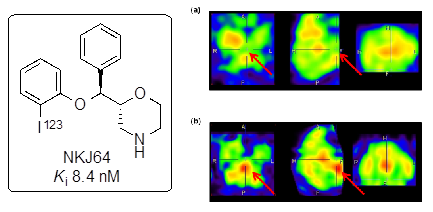Dr Andrew Sutherland
Design and Synthesis of Molecular Imaging Agents for Understanding Biological Mechanism and Disease
Many diseases are poorly diagnosed and treated due to a lack of understanding at the molecular level. One approach in gaining a better insight into disease mechanisms, is the design of non-toxic, molecular imaging agents that can bind with high affinity and high selectivity to a targeted biological receptor. The challenge is to generate functionalised molecular tracers that can produce insightful images of a specific biological target.
Effective imaging agents can be designed using state of the art molecular modelling and novel synthetic methodology leading to the rapid generation of libraries of small molecules. Testing of these with the biological target can identify a lead compound that can then be labelled and used as an imaging agent in combination with positron emission tomography (PET), single photon emission computed tomography (SPECT) or fluorescent spectroscopy.
Work in the Sutherland group has led to the development of one-pot, multi-bond forming tandem reaction processes that allow the rapid assembly of functionalised drug-like molecules. Used in combination with novel transition metal catalysed labelling techniques has allowed the generation of new, non-toxic molecular tracers for imaging a range of biological targets.
A. A. Cant, S. Champion, R. Bhalla, S. L. Pimlott and A. Sutherland, Nickel-Mediated Radioiodination of Aryl and Heteroaryl Bromides: Rapid Synthesis of Tracers for SPECT Imaging, Angew. Chem. Int. Ed., 2013, 52, 7829-7832.
A. Blair, L. Stevenson, D. Dewar, S. L. Pimlott and A. Sutherland, Structure-Activity Relationships of Novel Iodinated Quinloine-2-carboxamides for Targeting the Translocator Protein, Med. Chem. Commun., 2013, 4, 1461-1466.
M. W. Grafton, L. J. Farrugia, H. M. Senn and A. Sutherland, Discovery of a Multi-Bond Forming, Four-step Tandem Process: Construction of Drug-Like Polycyclic Scaffolds, Chem. Commun., 2012, 48, 7994-7996.


